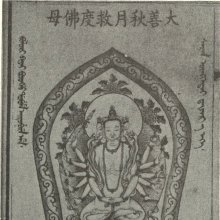Candrakanti, Candrakāntī, Candrakānti, Candra-kanti: 7 definitions
Introduction:
Candrakanti means something in Buddhism, Pali, Hinduism, Sanskrit, Marathi. If you want to know the exact meaning, history, etymology or English translation of this term then check out the descriptions on this page. Add your comment or reference to a book if you want to contribute to this summary article.
Alternative spellings of this word include Chandrakanti.
Images (photo gallery)
In Hinduism
Purana and Itihasa (epic history)
Source: Wisdom Library: Varāha-purāṇaCandrakāntī (चन्द्रकान्ती) is the name of a beautiful damsel (kanyā), with black curly hair and red lips, according to the Varāhapurāṇa chapter 92. Candrakāntī (and other innumerable ladies) arose out of the agitation of Vaiṣṇavī while she was doing penance at Viśālā. For these young women, Vaiṣṇavī created the city Devīpura, containing numerous mansions with golden balconies, crystal stairs and water fountains, with jewelled windows and gardens.
Vaiṣṇavī is the form of Trikalā having a red body representing the energy of Viṣṇu. Trikalā is the name of a Goddess born from the combined looks of Brahmā, Viṣṇu and Maheśvara (Śiva).
The Varāhapurāṇa is categorised as a Mahāpurāṇa, and was originally composed of 24,000 metrical verses, possibly originating from before the 10th century. It is composed of two parts and Sūta is the main narrator.

The Purana (पुराण, purāṇas) refers to Sanskrit literature preserving ancient India’s vast cultural history, including historical legends, religious ceremonies, various arts and sciences. The eighteen mahapuranas total over 400,000 shlokas (metrical couplets) and date to at least several centuries BCE.
In Buddhism
Tibetan Buddhism (Vajrayana or tantric Buddhism)
Source: Rangjung Yeshe Wiki: Dharma DictionaryCandrakānti (चन्द्रकान्ति) or Candrakāntitārā (in Tibetan: དཀར་མོ་ཟླ་མདངས་ཀྱི་སྒྲོལ་མ) refers to the “Tārā who is as white as autumn moon” and represents one of the twenty-one emanations of Tārā according to the Kashmiri Mahasiddha Suryagupta Tradition.—Suryagupta or Ravigupta (Tibetan: nyi ma be pa) was a layperson from Kashmir that was cured of leprosy by a miraculous statue of the goddess Tara. Suryagupta is famous for having many visions of Tara and originating many lineages of her practice such as the Twenty-one forms of Tara [e.g., Candrakānti-tārā]. There exists inscriptions and paintings (from the 14th century) of these Twenty-one Taras and they are also described in ritual and meditation texts in both Sanskrit and Tibetan language.

Tibetan Buddhism includes schools such as Nyingma, Kadampa, Kagyu and Gelug. Their primary canon of literature is divided in two broad categories: The Kangyur, which consists of Buddha’s words, and the Tengyur, which includes commentaries from various sources. Esotericism and tantra techniques (vajrayāna) are collected indepently.
Languages of India and abroad
Marathi-English dictionary
Source: DDSA: The Molesworth Marathi and English Dictionarycandrakāntī (चंद्रकांती).—a Fabled to be made of candrakānta;--used of spectacles &c.
Marathi is an Indo-European language having over 70 million native speakers people in (predominantly) Maharashtra India. Marathi, like many other Indo-Aryan languages, evolved from early forms of Prakrit, which itself is a subset of Sanskrit, one of the most ancient languages of the world.
Sanskrit dictionary
Source: DDSA: The practical Sanskrit-English dictionaryCandrakānti (चन्द्रकान्ति).—f. moon-light. -n. silver.
Derivable forms: candrakāntiḥ (चन्द्रकान्तिः).
Candrakānti is a Sanskrit compound consisting of the terms candra and kānti (कान्ति).
Source: Cologne Digital Sanskrit Dictionaries: Monier-Williams Sanskrit-English Dictionary1) Candrakānti (चन्द्रकान्ति):—[=candra-kānti] [from candra > cand] f. the brilliancy or lustre of the moon, moonlight, [Horace H. Wilson]
2) [v.s. ...] Name of the moon’s disc on the ninth day, [Brahma-purāṇa]
3) [v.s. ...] m. Name of a hero of Kālikā, [Vīracarita xxx.]
[Sanskrit to German]
Sanskrit, also spelled संस्कृतम् (saṃskṛtam), is an ancient language of India commonly seen as the grandmother of the Indo-European language family (even English!). Closely allied with Prakrit and Pali, Sanskrit is more exhaustive in both grammar and terms and has the most extensive collection of literature in the world, greatly surpassing its sister-languages Greek and Latin.
See also (Relevant definitions)
Partial matches: Candra, Kanti.
Starts with: Candrakanta, Candrakantitara, Candrakantiya.
Ends with: Candrakanta.
Full-text: Candrakanta, Citrakali, Shalabhanjika.
Relevant text
Search found 3 books and stories containing Candrakanti, Candrakāntī, Candrakānti, Candra-kanti, Candra-kānti; (plurals include: Candrakantis, Candrakāntīs, Candrakāntis, kantis, kāntis). You can also click to the full overview containing English textual excerpts. Below are direct links for the most relevant articles:
Garga Samhita (English) (by Danavir Goswami)
Verse 5.16.14 < [Chapter 16 - Comforting Sri Radha and the Gopis]
Verse 2.22.5 < [Chapter 22 - The Rāsa-dance Pastime]
Bhakti-rasamrta-sindhu (by Śrīla Rūpa Gosvāmī)
Verse 1.4.8 < [Part 4 - Devotional service in Love of God (prema-bhakti)]
Bhajana-Rahasya (by Srila Bhaktivinoda Thakura Mahasaya)
Text 27 < [Chapter 6 - Ṣaṣṭha-yāma-sādhana (Sāyaṃ-kālīya-bhajana–bhāva)]
Related products
